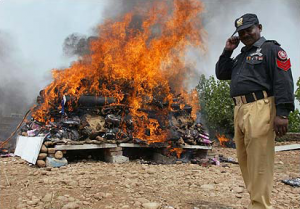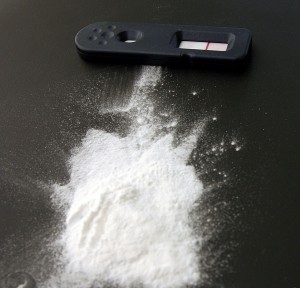Guinean Cocaine Seizure Goes Down in Flames
DATE: 2008-03-06 14:02:00
CLASSIFICATION: SECRET
ORIGIN: Embassy ConakrySUBJECT: SEIZED DRUGS FINALLY INCINERATED…OR WERE THEY?
SUMMARY: On April 11, 2008, Guinean police seized a shipment of cocaine, exact quantity unknown, and detained six suspects believed to be of Latin American origin. All [US government] requests for additional information regarding the details of the seizure or the suspects have gone unanswered. The [diplomatic] mission focused its efforts to ensure the destruction of the drugs and the result of these efforts proves that corrupt elements of the government are in full control. Exactly one month after the seizure, [the US] Ambassador and [members of the American Regional Security Office] attended the alleged incineration of 390 kilos of cocaine. The incineration was a farce that fooled no one and highlighted the possible complicity of the Guinean Minister of Interior and Security and high-level police officials.
A Long-Anticipated Event
Over a ten-day period, the [US diplomatic mission] in collaboration with the British Ambassador made several unsuccessful attempts to discuss the transparent destruction of the drugs. Finally, on May 2, 2008, the US and UK Ambassadors met with the [Guinean] Minister of Interior and Security and were given well-rehearsed assurances of the [Government of Guinea]’s commitment to combating drug trafficking and an invitation to view the drugs destruction. The incineration, initially planned for May 7 and rescheduled for May 9, finally took place on May 10, 2008.
Excuses, Excuses, Excuses
After consultations with DEA Paris, [the US] Ambassador requested permission to take a random sample of the cocaine for testing purposes. Controller General Diane automatically agreed, causing an immediate backlash from Director General Bangoura and [the anti-narcotics bureau] Director Mara. Director General Bangoura found several excuses, to include concern over [our] health and safety. He also explained that the cocaine had been treated with chemicals, rendering it useless. Director General Bangoura, in his usual arrogant and condescending fashion, refused to address the [US] Ambassador, claiming that this was not a matter of diplomacy, but police business. [Anti-narcotics bureau] Director Mara’s enraged response included direct accusations of infringement upon Guinean sovereignty. This heated exchange took place in a very public setting and was documented by the private press.
Theatrical Production
Upon the arrival of Minister of Interior and Security Keita and Minister of Justice Paulette Kourouma, the [US] Ambassador’s request for a random sample of the cocaine was quickly denied. The pile was immediately doused with gasoline and ceremoniously lit on fire by the Minister of Justice. The President of the National Committee Against Drug Trafficking was very dramatic in announcing the destruction of 160 kilos of marijuana, 390 kilos of cocaine and 43 boxes of pharmaceutical products (later explained to be expired ibuprofen). The destroyed narcotics were reportedly valued at 6.5 million dollars.
After the incineration, [the American Regional Security Office] was permitted to take a sample from a pre-designated package of cocaine. The [the anti-narcotics bureau] Deputy Director, the only individual that was allowed to get near the pile of narcotics, handpicked the package. On May 6, 2008, the [American Regional Security Office] [Foreign Service National] Investigator received a call from [name removed], who in the past weeks has provided [the Regional Security Office] with sensitive information on the drug seizure. [name removed] stated that the [Government of Guinea] planned to burn packages of flour. [The American Regional Security Office] is unable to prove that the cocaine was in fact substituted with flour; however, the [Government of Guinea]’s lack of cooperation and vehement rejection to a request for random sampling raises troubling questions about the [Government of Guinea]’s interest in transparency. And as the [US] Ambassador’s driver very keenly observed, “I know the smell of burning marijuana, and I didn’t smell anything.” The entire event was a theatrical production.
Thankfully the US Ambassador’s driver was there to recognize the smell of burning marijuana, or else the seizure may have remained a mystery to this day.
The event was a real eye-opener and a facade. The incineration was a ridiculous attempt by the [Government of Guinea] to prove that a law enforcement campaign against narcotics exists. If anything was proven, it was that the traffickers’ influence has reached the highest levels of the government. There is an obvious fracture within the security forces, and only a handful of officials appear to be fighting to carry out legitimate duties. The clear reluctance and open animosity displayed by all the senior Ministry of Interior and Security (MIS) officials and the diffident response of the Ministers to the [US] Ambassador’s request suggest complicity at the highest levels of the Ministry. The silver-lining of the event is that the heated debate and ridiculous protestation by MIS to the Ambassador’s request for a random sampling were witnessed and recorded by elements of the Guinean media (state-owned and independent).
From Cable Reference ID 08CONAKRY184, 2008-03-06 14:02:00, Classification SECRET, Origin Embassy Conakry.




No comments yet.